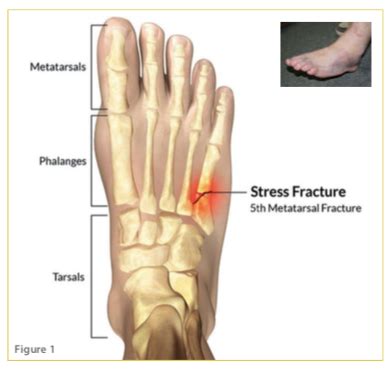The frustration and pain of suffering a Jones fracture, a common yet debilitating injury affecting the fifth metatarsal bone in the foot. For those unfortunate enough to experience this type of fracture, understanding the available treatment options is crucial for a successful recovery. In this article, we will delve into the world of Jones fracture treatment, exploring the various methods available, from conservative management to surgical intervention, and provide valuable insights to help individuals make informed decisions about their care.
Understanding Jones Fractures
Before diving into treatment options, it’s essential to comprehend what a Jones fracture is. This specific type of fracture occurs at the base of the fifth metatarsal bone, which is located on the outer aspect of the foot. The name “Jones fracture” was coined after Sir Robert Jones, an orthopedic surgeon who first described the injury in 1902. Jones fractures are typically caused by overuse, repetitive stress, or acute trauma to the area, leading to a break in the bone.
Conservative Management
For some individuals, conservative management may be the recommended course of treatment for a Jones fracture. This approach typically involves a combination of the following:
- Immobilization: The use of a cast, boot, or other immobilizing device to reduce movement and stress on the affected area, allowing the bone to heal naturally.
- Pain Management: Over-the-counter or prescription medications to manage pain and discomfort.
- Rest and Ice: Avoiding activities that exacerbate the injury and applying ice to reduce inflammation.
- Physical Therapy: Gentle exercises and stretches to maintain range of motion and strength in the foot and ankle.
While conservative management can be effective for some, it’s crucial to note that this approach may not be suitable for all types of Jones fractures, particularly those that are displaced or have a high risk of nonunion (failure to heal).
Surgical Intervention
In cases where conservative management is not advised or has been unsuccessful, surgical intervention may be necessary. The primary goal of surgery is to stabilize the fracture, promote healing, and restore function to the foot. Several surgical techniques are available, including:
- Intramedullary Screw Fixation: This involves inserting a screw into the bone to stabilize the fracture. This method is often preferred for its minimal invasiveness and low risk of complications.
- Plate and Screw Fixation: For more complex fractures, a plate and multiple screws may be used to provide additional stability.
- Bone Grafting: In cases where the fracture is not healing properly (nonunion), a bone graft may be necessary to stimulate the healing process.
Comparative Analysis of Treatment Options
When deciding between conservative management and surgical intervention, several factors must be considered, including the severity of the fracture, the individual’s overall health, and their personal preferences. The following table provides a summary of the key differences between these approaches:
| Treatment Option | Advantages | Disadvantages |
|---|---|---|
| Conservative Management | Less invasive, lower risk of complications, potentially lower cost | May not be effective for all types of fractures, longer recovery time |
| Surgical Intervention | Higher success rate for complex fractures, faster recovery time | More invasive, higher risk of complications, potentially higher cost |

Decision Framework for Choosing the Right Treatment
The decision to undergo conservative management or surgical intervention should be made in consultation with an orthopedic specialist. The following criteria can help guide this decision:
- Fracture Severity: The severity of the fracture, including whether it is displaced or non-displaced, plays a significant role in determining the most appropriate treatment.
- Individual Health: The overall health of the individual, including any underlying medical conditions, must be considered.
- Lifestyle and Activity Level: The individual’s lifestyle and activity level can influence the choice of treatment, with more active individuals potentially requiring surgical intervention to ensure a speedy and full recovery.
- Personal Preferences: Ultimately, the decision should also take into account the individual’s personal preferences and values.
Future Trends in Jones Fracture Treatment
As medical technology continues to evolve, so too do the treatment options for Jones fractures. Emerging trends include the use of advanced biomaterials for bone grafting, innovative surgical techniques that minimize invasiveness, and personalized medicine approaches that tailor treatment to the individual’s unique genetic and physiological profile.
Practical Application Guide
For individuals recovering from a Jones fracture, whether through conservative management or surgical intervention, the following practical tips can aid in the recovery process:
- Follow Postoperative Instructions Closely: Adhering to the postoperative instructions provided by your healthcare provider is crucial for minimizing the risk of complications and ensuring a smooth recovery.
- Maintain a Healthy Lifestyle: Eating a balanced diet rich in calcium and vitamin D, staying hydrated, and avoiding smoking can promote bone health and support the healing process.
- Gradually Increase Activity: As healing progresses, gradually increasing activity levels under the guidance of a healthcare provider can help restore strength and function to the foot.
FAQ Section
What are the symptoms of a Jones fracture?
+Symptoms of a Jones fracture may include severe pain on the outer aspect of the foot, swelling, bruising, and difficulty walking or bearing weight on the affected foot.
How long does it take for a Jones fracture to heal?
+The healing time for a Jones fracture can vary significantly depending on the severity of the fracture and the chosen treatment method. Conservative management may require several months, while surgical intervention can lead to a faster recovery, typically within 6-12 weeks.
Can I prevent a Jones fracture?
+While not all Jones fractures can be prevented, wearing appropriate footwear, gradually increasing activity levels, and maintaining a healthy weight can reduce the risk of experiencing this type of injury.
In conclusion, treating a Jones fracture requires a thoughtful and individualized approach, taking into account the severity of the fracture, the individual’s health and lifestyle, and their personal preferences. By understanding the available treatment options and being proactive in the recovery process, individuals can navigate the challenges of a Jones fracture and return to their normal activities with confidence and optimal foot health.



